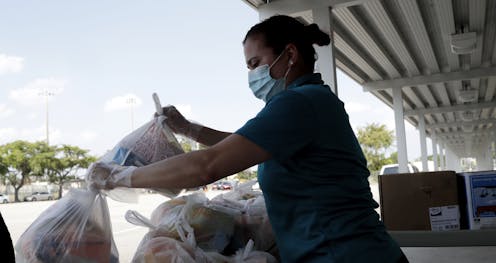How Connecticut's schools have managed to maintain lunch distribution for kids who need it most during the COVID-19 pandemic
- Written by Marlene B. Schwartz, Professor of Human Development and Family Sciences, University of Connecticut

The Research Brief[1] is a short take about interesting academic work.
The big idea
Connecticut schools ensured that low-income students were still getting enough to eat after the pandemic first shuttered buildings in March because of a swift shift in how staff prepared and distributed cafeteria food, according an article we recently published in a peer-reviewed journal[2].
When the state’s school buildings closed because of the COVID-19 pandemic in mid-March 2020, the estimated share of children facing economic hardship who received a school lunch quickly fell to 42% from 62%. But by April and May, Connecticut schools were serving about the same number of school lunches[3] as they had served to low-income children during the same months the previous school year.
The initial decline put Connecticut’s nearly 230,000 students who are eligible for free or reduced-price meals[4] at a greater risk of not getting enough to eat. The state avoided this outcome because school food service staff members changed their preparation, packaging and distribution methods to feed students who were no longer eating in cafeterias.
My colleagues and I came to this conclusion after analyzing statewide meal-distribution data from 120 districts and conducting extensive interviews with food service directors from eight school systems around Connecticut. The food service directors were selected to represent urban, rural and suburban districts from different regions of the state.
Most Connecticut school districts established “grab-and-go[5]” distribution at their shuttered school buildings once they switched to virtual learning. We also heard about rural districts employing bus drivers to deliver meals to students’ homes. Some districts made an effort to establish food-distribution sites at community centers, libraries, fire departments and child care centers near where low-income students live.
Trial and error was the rule. Most districts began by adjusting staffing and schedules, as well as the number of distribution sites and their locations. They needed to experiment at first with packaging materials to ensure meals were portable, safe and ready to reheat. We heard from many sources that communication with families was crucial, since it was important to let everyone know when and where meals would be available and what was on the menu. Schools used every channel available – email, robocalls, social media, text messages and websites. One local food service director had staff personally call families. Others had principals record messages or local clergy do outreach. Everything needed to be translated into Spanish to reach all families. And undocumented parents needed to be reassured that no one was checking for immigration status at the distribution sites.
[Deep knowledge, daily. Sign up for The Conversation’s newsletter[6].]
The food service directors said that these efforts all helped to increase participation.
Why it matters
One consequence of the COVID-19 pandemic has been the increase in food insecurity[7], the technical term for the inability to get enough food for financial or logistical reasons. According to a recent survey, 10% to 15% of adults living with children[8] said their children either sometimes or often didn’t eat enough in the previous week because they couldn’t afford enough food. Research has shown that the National School Lunch Program[9], which funds these meals, reduces food insecurity and improves student nutrition[10].
What still isn’t known
The meal distribution data and interviews generated a snapshot of how Connecticut initially tackled this challenge. We still don’t know which strategies made the biggest difference, and which have continued to be used across the state or nation. Research on the impact of keeping up free school meals on child food insecurity rates during the pandemic, as well as other health and academic outcomes, will be important.
A careful evaluation of the innovation taking place in the 2020-2021 school year may yield ideas on how to improve school meals in the long term.
References
- ^ Research Brief (theconversation.com)
- ^ peer-reviewed journal (doi.org)
- ^ same number of school lunches (doi.org)
- ^ 230,000 students who are eligible for free or reduced-price meals (ctschoolfinance.org)
- ^ grab-and-go (edsource.org)
- ^ Sign up for The Conversation’s newsletter (theconversation.com)
- ^ increase in food insecurity (theconversation.com)
- ^ 10% to 15% of adults living with children (www.cbpp.org)
- ^ National School Lunch Program (www.ers.usda.gov)
- ^ reduces food insecurity and improves student nutrition (theconversation.com)
Authors: Marlene B. Schwartz, Professor of Human Development and Family Sciences, University of Connecticut

